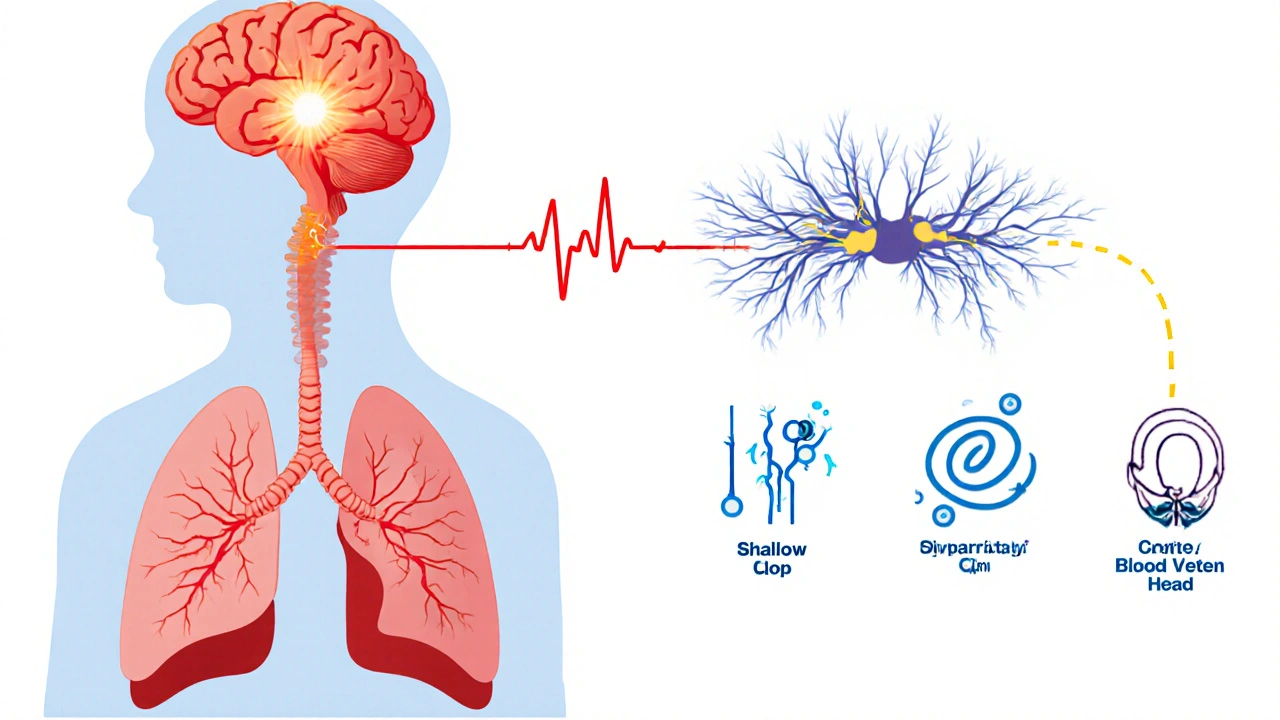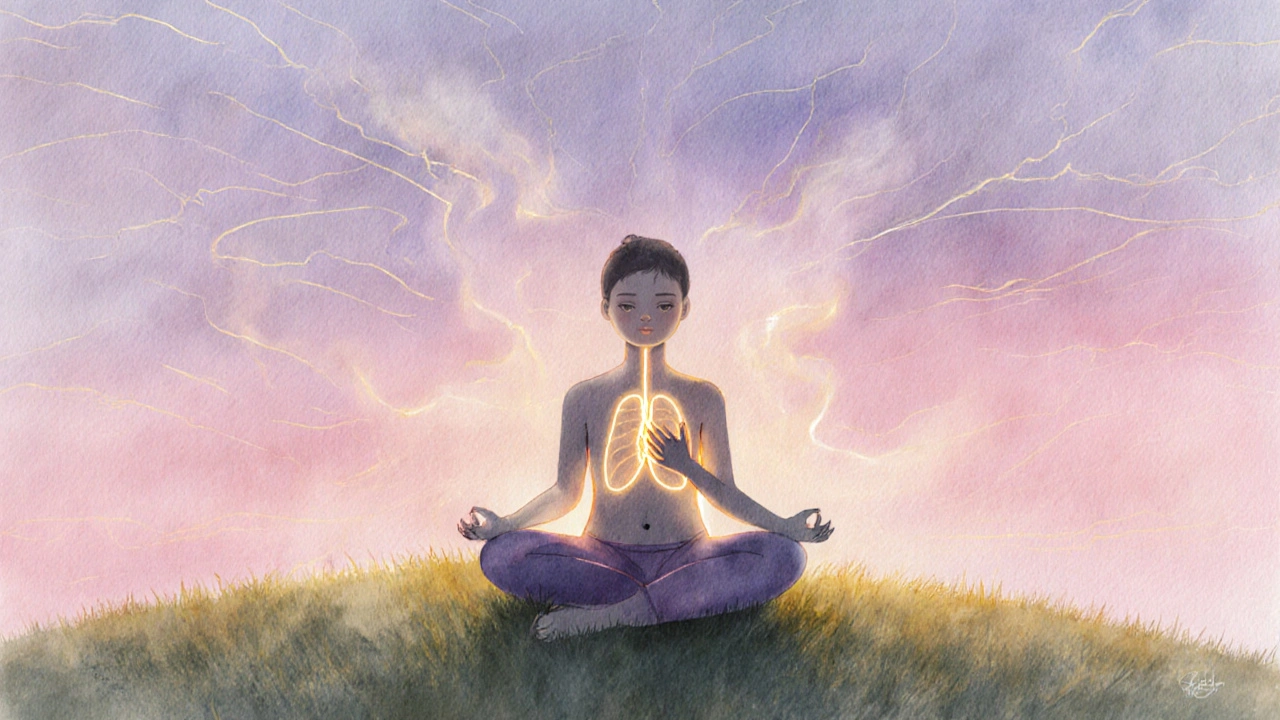Anxiety & Breathing Symptoms Checker
Analysis Result
When Anxiety is a feeling of excessive worry or fear that activates the mind and body. It can cause racing thoughts, muscle tension, and a host of physical reactions.
At the same time, Breathing Disorders are conditions that impair the normal flow of air into and out of the lungs, ranging from chronic illnesses like asthma to acute episodes such as hyperventilation.
Understanding the link between anxiety and breathing disorders helps you spot early warning signs and take practical steps before the problem spirals.
Key Takeaways
- Anxiety can directly change breathing patterns, leading to shortness of breath or panic attacks.
- Common breathing disorders that overlap with anxiety include hyperventilation, asthma, and COPD.
- The body’s stress response, driven by the autonomic nervous system, is the main physiological bridge.
- Simple breathing techniques and lifestyle tweaks can break the anxiety‑breath cycle.
- Seek professional help if symptoms persist, worsen, or interfere with daily life.
What Anxiety Really Does to Your Body
During an anxious episode, the brain sends a surge of signals through the Autonomic Nervous System (ANS), the part of the nervous system that runs involuntary functions like heartbeat and digestion. The ANS flips into “fight‑or‑flight” mode, releasing adrenaline and cortisol.
Two key outcomes affect breathing:
- Increased respiratory rate: The body tries to take in more oxygen to prepare for action.
- Shallow, chest‑focused breaths: The diaphragm sits still while the upper chest muscles do most of the work.
Both changes can create a sensation of not getting enough air, which then fuels more anxiety - a classic feedback loop.
Breathing Disorders That Often Appear With Anxiety
Not every shortness of breath signals a chronic disease, but several breathing disorders share symptoms with anxiety‑driven hyperventilation.
Panic Attack is a sudden surge of intense fear that peaks within minutes. It frequently includes rapid breathing, a feeling of choking, and chest tightness.
Hyperventilation occurs when you breathe faster than your body needs, lowering carbon‑dioxide levels and causing dizziness, tingling, or faintness. Anxiety is the most common trigger.
Asthma is a chronic inflammatory disease of the airways that leads to wheezing, coughing, and breathlessness. Stress and anxiety can provoke asthma flares by tightening airway muscles.
COPD (Chronic Obstructive Pulmonary Disease) is a progressive condition, often linked to smoking, that reduces airflow. Anxiety can worsen COPD symptoms by increasing the work of breathing.
Even everyday Stress can make the Diaphragm contract irregularly, leading to the same shallow pattern seen in panic attacks.

Physiological Bridge: How Anxiety Turns Into Breathing Trouble
The chain reaction looks like this:
- Anxiety spikes → ANS releases adrenaline. \n
- Adrenaline tells the lungs to “gear up,” raising the breathing rate.
- Shallow breaths reduce carbon‑dioxide (CO₂) levels.
- Low CO₂ causes blood vessels to constrict and triggers sensations of light‑headedness.
- The brain interprets these sensations as danger, feeding the anxiety loop.
In people with existing asthma or COPD, this loop can tip a manageable situation into a medical emergency.
Practical Ways to Break the Cycle
Here are evidence‑based steps you can try the next time anxiety starts messing with your breath.
1. Diaphragmatic Breathing
Place one hand on your chest and the other on your belly. Inhale slowly through the nose for a count of four, feeling the belly rise. Exhale gently through pursed lips for a count of six. This engages the diaphragm, normalises CO₂, and signals the ANS to calm down.
2. Box Breathing (4‑4‑4‑4)
Inhale for four seconds, hold for four, exhale for four, and hold again for four. Repeat three to five cycles. The structured rhythm reduces the heart rate and interrupts the panic loop.
3. Grounding Techniques
While breathing, name five things you can see, four you can touch, three you can hear, two you can smell, and one you can taste. This shifts focus from internal sensations to external reality, lowering anxiety levels.
4. Physical Activity
Regular cardio (walking, cycling, swimming) improves lung capacity and releases endorphins that counter stress hormones.
5. Professional Help
If breathing issues persist, consider seeing a therapist trained in cognitive‑behavioral therapy (CBT) or a respiratory specialist. CBT teaches you to reframe catastrophic thoughts that trigger hyperventilation.
Comparison Table: Anxiety‑Induced Hyperventilation vs Asthma Attack
| Feature | Hyperventilation (Anxiety) | Asthma Attack |
|---|---|---|
| Primary trigger | Stress, panic, fear | Allergens, cold air, exercise |
| Breathing pattern | Rapid, shallow, chest‑dominant | Wheezing, prolonged exhalation |
| CO₂ levels | Often low (hypocapnia) | Usually normal |
| Typical sensations | Dizziness, tingling, light‑headedness | Chest tightness, coughing |
| Response to bronchodilator | Minimal effect | Often rapid relief |

When to Call a Doctor
If you notice any of the following, seek medical advice promptly:
- Breathlessness that doesn’t improve after 10 minutes of calming techniques.
- Chest pain radiating to the arm or jaw.
- Blue‑tinged lips or fingernails (sign of low oxygen).
- Frequent nighttime awakenings due to breathing difficulty.
- Any new or worsening wheezing, especially if you have a known lung condition.
Emergency services are appropriate for sudden, severe shortness of breath, loss of consciousness, or signs of a heart attack.
Lifestyle Habits That Support Both Mind and Lungs
- Maintain a balanced diet rich in magnesium and B‑vitamins; deficiencies can heighten anxiety.
- Limit caffeine and nicotine, both of which stimulate the ANS.
- Prioritise sleep - 7‑9 hours helps regulate stress hormones.
- Practice mindfulness meditation for at least 10 minutes daily.
- Stay up‑to‑date with inhaler technique if you have asthma; improper use can mimic anxiety‑related breathlessness.
Frequently Asked Questions
Can anxiety cause long‑term lung damage?
Anxiety itself doesn’t damage lung tissue, but chronic hyperventilation can lead to respiratory alkalosis, which may exacerbate existing conditions like asthma. Managing anxiety reduces the chance of repeated flare‑ups that could harm lung function over time.
Why does my chest feel tight during a panic attack?
The tightness comes from shallow, rapid breaths that engage the upper chest muscles. This pattern limits diaphragm movement and makes the airway feel constricted, which the brain interprets as danger.
Are breathing exercises safe for asthma patients?
Yes, when done correctly. Techniques like diaphragmatic breathing improve airway control and reduce reliance on rescue inhalers. Patients should start under the guidance of a respiratory therapist.
What’s the difference between hyperventilation and normal fast breathing?
Normal fast breathing (e.g., after a run) matches the body’s oxygen demand. Hyperventilation lowers CO₂ too much, leading to symptoms like dizziness and tingling, which aren’t seen in typical exertion.
Can medication for anxiety help with breathing problems?
Selective serotonin reuptake inhibitors (SSRIs) and certain benzodiazepines reduce overall anxiety, which can indirectly lessen hyperventilation episodes. They should be prescribed after evaluating any underlying respiratory condition.







Shivam yadav
October 8, 2025 AT 12:43Many people from my region notice that the rapid breathing during stress feels like a hidden fire brewing inside.
We often use simple yoga breathing exercises passed down through families to calm the mind.
Try placing a hand on your belly and breathing slowly for four counts, then exhale for six.
This can lower the adrenaline surge and give the diaphragm a chance to relax.
Consistent practice can break the anxiety‑breath loop over weeks.
pallabi banerjee
October 11, 2025 AT 22:49Understanding how anxiety hijacks our breath helps us choose gentle ways to restore balance.
Alex EL Shaar
October 15, 2025 AT 08:56Yo, that hyperventilation thing is like your lungs doing a rave without a DJ.
When stress hits, you start gulping air like a goldfish on a treadmill.
Stop that by doing box breathing – inhale‑hold‑exhale‑hold, four seconds each, repeat.
Trust me, the brain loves that rhythm, it calms the fight‑or‑flight circus.
Anna Frerker
October 18, 2025 AT 19:03Short breathing hacks work, but if you keep feeling like you can't catch air, see a doc.
Julius Smith
October 22, 2025 AT 05:09Wow, love the table! 😮 It really shows how anxiety‑driven breaths differ from asthma.
Keep those breathing drills handy – they saved me during a panic episode last week. 👍
Brittaney Phelps
October 25, 2025 AT 15:16Great rundown! Remember, a quick 5‑minute diaphragmatic session each morning can boost both mood and lung capacity.
Kim Nguyệt Lệ
October 29, 2025 AT 00:23The physiological explanation linking the autonomic nervous system to shallow breathing is accurate and well‑structured.
Rhonda Adams
November 1, 2025 AT 10:29Thanks for the clear guide! 😊 I’ve started the 4‑4‑4‑4 box breathing and already notice less chest tightness during work stress.
Macy-Lynn Lytsman Piernbaum
November 4, 2025 AT 20:36Breathing through anxiety feels like choking on invisible smoke.
Alexandre Baril
November 8, 2025 AT 06:43If you have asthma, keep a rescue inhaler nearby while practicing breathing exercises, because sudden stress can tighten airway muscles.
Also, tracking triggers in a simple journal helps you and your doctor spot patterns.
Stephen Davis
November 11, 2025 AT 16:49Anxiety often masquerades as a respiratory issue, making it hard to tell whether the root cause is mental or physical. The body’s fight‑or‑flight response ramps up heart rate and forces the lungs to take rapid, shallow breaths. This shallow pattern bypasses the diaphragm, leaving the chest muscles overworked and the feeling of not getting enough air. As CO₂ levels drop, the blood pH shifts toward alkalinity, which can cause tingling in the fingers and a sense of dizziness. The brain interprets these sensations as danger, feeding the anxiety loop even further. Over time, repeated episodes can condition the respiratory system to respond with hyperventilation at the slightest stress cue. People with pre‑existing conditions like asthma may experience bronchoconstriction triggered by the same stress hormones. In such cases, the anxiety‑induced breathlessness can quickly evolve into a genuine asthma flare‑up. Understanding this cascade lets you intervene early with targeted breathing techniques. Diaphragmatic breathing encourages full lung expansion, restoring normal CO₂ levels and sending calming signals to the nervous system. Box breathing imposes a structured rhythm that disrupts the chaotic pattern of panic breaths. Regular mindfulness meditation trains the mind to notice early warning signs before the physiological cascade escalates. Physical activity, especially aerobic exercise, improves overall lung capacity and resilience to stress. Adequate sleep and nutrition, particularly magnesium‑rich foods, support the nervous system’s balance. Finally, if symptoms persist despite self‑help strategies, consulting a therapist trained in CBT and a respiratory specialist is advisable to address both mind and body.
Grant Wesgate
November 15, 2025 AT 02:56Excellent breakdown! Adding a daily 5‑minute breathing pause after lunch could reinforce the habits you described.
Richard Phelan
November 18, 2025 AT 13:03Honestly, the article reads like a self‑help brochure that forgot to mention the real danger of ignoring serious pulmonary disease.
benjamin malizu
November 21, 2025 AT 23:09From a psychosomatic perspective, the bidirectional dysregulation of the hypothalamic‑pituitary‑adrenal axis precipitates a neuroventilatory mismatch, warranting integrative psychophysiological intervention.
Maureen Hoffmann
November 25, 2025 AT 09:16That’s a solid point; coupling CBT with pulmonary rehab can target both the cognitive distortions and the ventilatory instability you highlighted.
Alexi Welsch
November 28, 2025 AT 19:23While the presented strategies are beneficial, a more critical appraisal reveals an overreliance on breath‑control techniques without sufficient empirical validation in heterogeneous clinical populations.